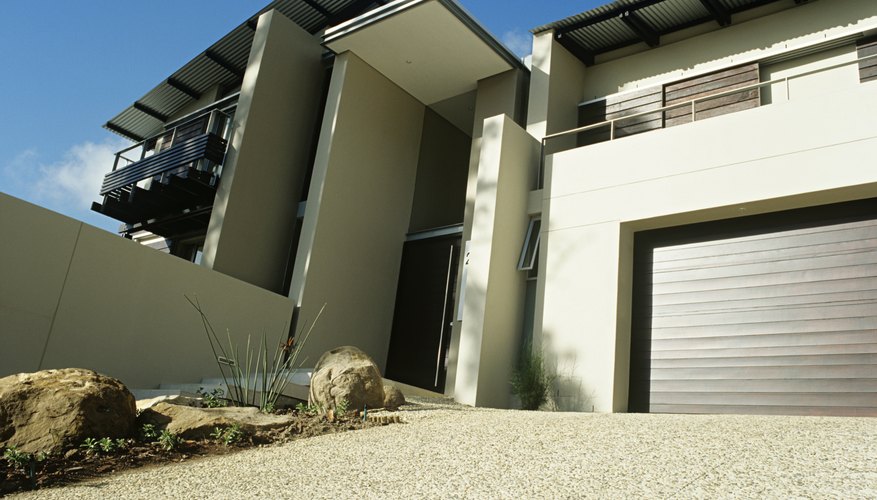A garage space is often far more than a place to park a car.
It can also serve as a workshop for weekend projects or an activity space for the kids, but it is typically unheated. Adding a small wood stove will improve the space for comfortable year-round use. The safe, basic installation procedure can be adapted to any wood stove and installation preference.
- A garage space is often far more than a place to park a car.
- The safe, basic installation procedure can be adapted to any wood stove and installation preference.
Place the stove unit in the desired location in the garage to complete a preliminary measuring for the wall covering and chimney system's ceiling and roof penetration. Consult the manufacturer's specifications for non-combustible wall clearances and make certain the stove position meets or exceeds these requirements.
Mark a line on the ceiling for the chimney opening, using a plumb bob over the centre of the chimney connection flange on the stove.
Mark a circle to the diameter of the chimney sections that penetrate the ceiling and roof, using a scribing compass. Add 10 cm (4 inches) to the diameter of the hole to allow for a typical minimum clearance to any combustible material, such as ceiling joists or the roof structure. Adjust the stove position or chimney configuration as necessary to keep the chimney's roof penetration as close to centred between roof rafters and ceiling joists as possible.
Cut through the ceiling plasterboard, if applicable, using a jab saw or Stanley knife. Cut the ceiling hole to accommodate the metal chimney collar.
Cut the roof sheathing and roofing around the outline of the circle centred on the stove connection, using a jigsaw or reciprocating saw.
- Mark a circle to the diameter of the chimney sections that penetrate the ceiling and roof, using a scribing compass.
- Cut the roof sheathing and roofing around the outline of the circle centred on the stove connection, using a jigsaw or reciprocating saw.
Clear away the roofing around the opening. Prepare the roof and install the chimney collar flashing, following the chimney manufacturer's instructions. Verify the hole's correct location, using a plumb bob lowered through the ceiling hole.
Measure out a space on the concrete floor under the wood stove from the wall line behind the stove to a perpendicular point 45 cm (18 inches) beyond the front edge of the stove's door opening. Use a framing square to align the tape measure.
Move the stove unit away to access the rear wall.
Cover an unfinished garage wall, one with no plasterboard installed, with a full sheet of fire-rated plasterboard, positioned horizontally and centred, keeping a minimum of 1.2 m (48 inches) on each side from the centre line of the stove location. Attach to the garage wall with plasterboard screws and a screwdriver. For corner installations, extent the fire-rated plasterboard 1.2 m (48 inches) each way from the corner behind the stove.
- Measure out a space on the concrete floor under the wood stove from the wall line behind the stove to a perpendicular point 45 cm (18 inches) beyond the front edge of the stove's door opening.
- Cover an unfinished garage wall, one with no plasterboard installed, with a full sheet of fire-rated plasterboard, positioned horizontally and centred, keeping a minimum of 1.2 m (48 inches) on each side from the centre line of the stove location.
Place a full sheet of cement backer board 90 cm (36 inches) high and centred horizontally with the centre line of the stove. Do not extend the cement backer board beyond the end of the fire-rated plasterboard. Attach to the wall framing with cement board screws and a screwdriver at approximately 20 cm (8 inches) apart on each stud.
Relocate the wood stove into place and use a tape measure to verify all the required clearances.
Connect the chimney sections. Pass the joined chimney assembly through the roof opening and collar flashing, then slide the base of the chimney assembly over the chimney flange on the stove top. Attach the chimney to the stove flange according to the manufacturer's instructions.
- Relocate the wood stove into place and use a tape measure to verify all the required clearances.
- Pass the joined chimney assembly through the roof opening and collar flashing, then slide the base of the chimney assembly over the chimney flange on the stove top.
Attach the counter-flashing, called a "storm collar," over the roof collar flashing. Run a continuous bead of silicone caulking around the perimeter gap between the storm collar's inside edge and the chimney's vertical surface.
Install the chimney cap. Make certain the cap snaps fully locked onto the top of the chimney assembly.
Open the chimney flue by turning the metal handle on the side of the chimney, typically about 1.5 or 1.8 m (5 or 6 feet) above the floor.
Light a small newspaper fire in the stove firebox, using matches. Adjust the flue as needed to sustain an even smoke draft up the chimney.
TIP
Wood stoves must be installed on a fireproof surface and a concrete garage slab is ideal. A single layer of bricks, concrete pavers or ceramic tile can also be installed to add an aesthetic detail or more definition to the wood stove installation. Wood stoves are available in a range of sizes and heating capacities, and consulting a wood stove dealer can ensure you choose the right stove for your needs.
WARNING
The wall surface behind a wood stove must be protected with a non-combustible material or the stove must be equipped with a rear heat shield. It is recommended you consult your local planning department to verify compliance with building regulations before beginning this project.
